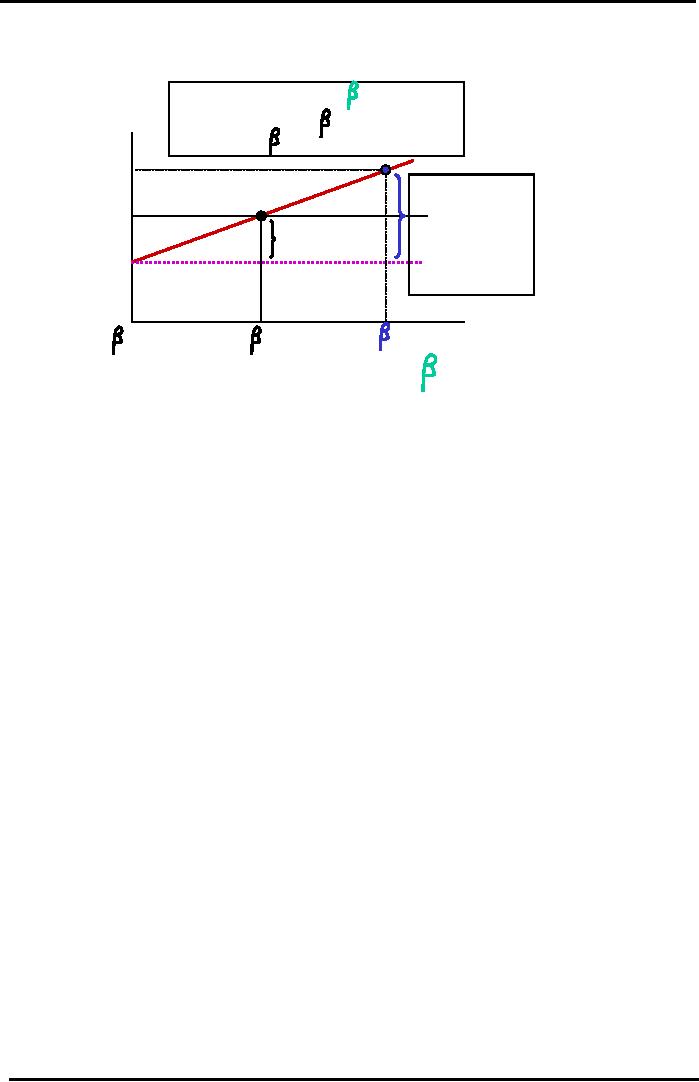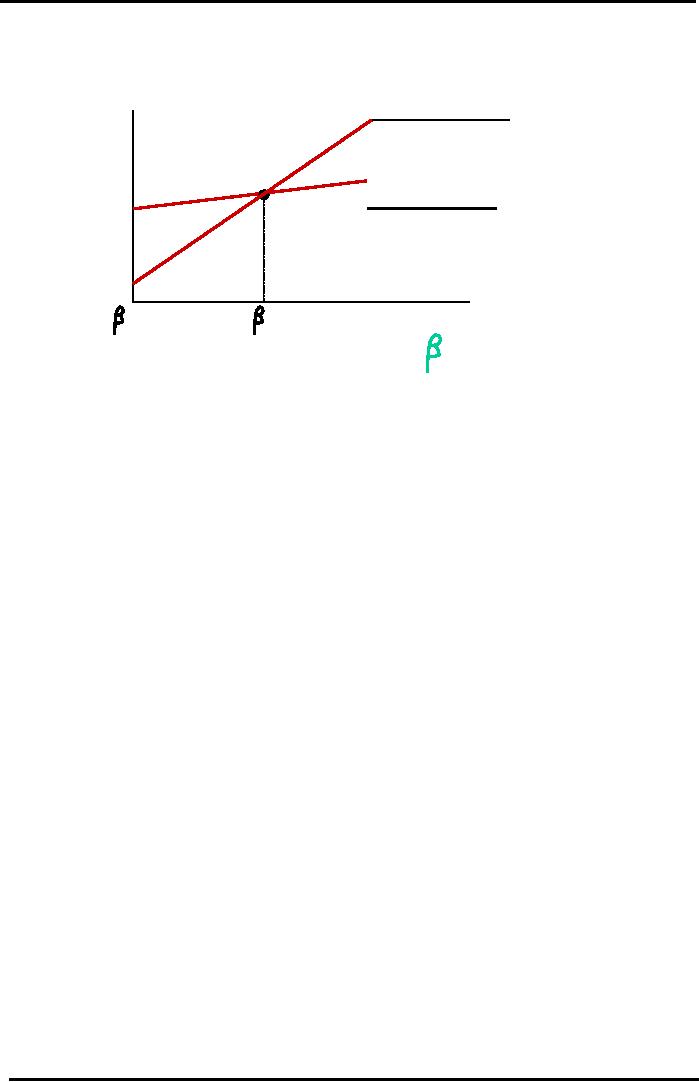 |

Financial
Management MGT201
VU
Lesson
26
SML
GRAPH AND CAPITAL ASSET PRICING
MODEL
Learning
Objectives:
After
going through this lecture,
you would be able to have an
understanding of the following
topics.
�
SML
Graph & CAPM
We
will continue our discussion
on risk. It is very important in
our daily life .we
are always
concerned
with risky situation. There
is risk that you can
not watch this lecture due
to the power failure.
We
have to know that how we can
measure and control the risk in
every day life. We are
going to see
that
how we can use required rate
of return that we calculated by using the
SML equation and use
that
required
rate of return for the calculation we
have been doing in the first
two parts of this course. In
first
part
we did capital budgeting and
NPV calculations and in the
NPV formula the `r' we are
using is the
required
rate of return not he expected rate of
return. We can use the value
of required return from
SML
equation
in stock or bond pricing. We have studied
that in the efficient markets the
required rate of
return
is come from the market
return. There are two
methods for the calculation of
risk.
First
approach the experimental cost base in
this approach we use expected rate of
return and market
index.
Then we plot these points on
the graph and we join them with a
straight line called
regression line
and
slope of this line is called
beta co- efficient.
The
second approach for its
calculation is called theoretical
beta of stock:
Beta
Stock A = σ
A
σ
M
ρ
AM
/ σ 2
M
=
σ
A
ρ
AM
/ σ M
Extent
to which Actual Stock Return
Data lies on Regression
Line
Total
Risk = Market Risk + Random
Company Specific Risk If the
experimental data
points
All
lies exactly on the regression
line then this particular stock
has only market
risk.
Theoretical
Market Risk of a
Stock:
Market
Risk of Stock A = β
A
σ
M
= σ A
ρ AM
Extent
to which Actual Stock Return
Data lies on Regression
Line
The
third formula which we
discussed is very important and
cornerstone of the CAPM.
Security
Market Line (SML) and
Required Rate of Return (rA):
It
allows us that the value
which we have calculated for the
beta and from that
calculate
the
required rate of return of the stock and
then we use for stock
pricing. So, then the
required rate of
return
for any stock A is equal
to
rA =
rRF + (rM
- rRF )
β
A
.
In
Efficient Markets, Stock Price
(and Value) depends on
Required Return which
depends on Market
Risk
(not the Total Risk).
The
required rate of return in efficient
markets depends upon the
risk premium which depends
only
upon
the market risk and not on the
total risk. We do not have to
worry about company's risk
because
we
assume that investors are
rational and maintain diversified
portfolio. Now, let's take a
look at the
security
market line graphically .It
is important to understand this graph and
many things that it tells
us.
112

Financial
Management MGT201
VU
Security
Market Line (SML)
For
Efficient Stocks
rA =
rRF +
(rM -
rRF )
yA
.c + mx
where x = and m = Slope
=
Required
=
(rM -
rRF) / ( M -
0) = (rM -
rRF) /1
Return
(r*)
rA= 30%
Risky
Stock A's
Security
Market Line
Risk
Premium
=
rM=
20%
Market
Risk
30-10
= 20.
Premium
for
Based
on Market
Avg
Stock =
rRF= 10%
Risk
(not Total
10%
Risk)
A
=+ 2.0
M
=+ 1.0
RF
= 0
Beta
Risk (
)
The
graph represents the SML in the efficient
stock market. On y axis we have
required rate of
return
r* for the stock A for and risk
free rate of return and on the x- axis is
beta risk which
represents
the
market risk. SML is straight
line and it tells us the
relationship between the market risk and
the
required
return. it starts on the left hand
side from risk free rate of
return and it passes through
a point
ion
the middle which is the overall
market point. This point is
located at the beta of +1.0 and at
the
required
return of 20%.This means
that the market offers a rate of
return which is higher then
the risk
free
rate of return. Because the market
fluctuates it has a risk of
1.0 and not 0. if we extend
the line it
passes
through the point where the beta is
+2.0 and the required return
is 30%.because this point
lies on
the
SML it means that stock A has no company
risk & what is the risk
premium ?
Risk
premium=rA-rRF=30%-10%=20%.
It
is directly proportion to market
risk of stock.
Please
note that slope of this line
is = (rM-rRF)/
(betaM-0) = (rM-rRF)/1.
This is the measure
tendency
of the average investors in the market to
take risk. If the SML line is
steeper the investors will
not
take unnecessary risk. In
other words they are risk
aversive as the slope increase the avoidance
for
the
risk also increases in the
market as whole. It is very
important to formulate the equation
for SML
You
should be able understand the various
points that lie on the SML
line including the risk free
rate of
return
or T-BILL return as well as the
market point and you should
also understand that the slope of
SML
line is=(rM-rRF)/(betaM-0)=(rM-rRF)/1.Beta
coefficient was the slope of the line
for different graph
that
graph shows the stock rate of
return on y-axis and market rate of
return on x-axis. But over
there
we
are not talking about the
required rate of return we were talking
about the expected rate of return
so;
do
not confuse these two
different graphs. SML exist
for only the efficient
markets or perfect
capital
markets.
SML tells us in detail that
rational investor will
eliminate the company's specific
risk and the
total
risk of the company will be equal to the
market risk of the company. SML
line is an ideal case
and
in
efficient markets all the
stocks lie on the SML line. If stock is
not on SML then according to
market
equilibrium
it will come back on SML. If
any stock is not on SML then
forces of market
equilibrium
will
bring it on the security market
line. If risk and return
combination of any stock is above SML
it
means
that it is offering the higher rate of
return as compare to efficient stock.
The people will rush
to
buy
such stock when the demand
will increase the return
will decrease.
If
any stock is lying below the SML
line the price will come
down it will offer as
much
potential
as the efficient stock offers. The
supply for such stock will
increase and it will offer
higher
return
in form of capital gain. So,
the market forces will throw
these points on the SML.
Markets are not
risk
free .markets index
fluctuate .The investors expect that
market return will be more
than the average
expected
return.
113

Financial
Management MGT201
VU
Security
Market Line (SML)
Slope
& Risk Taking
Required
Steep
Slope SML
Return
(r*)
Most Investors
Avoid
Investors
rM=
20%
Low
Slope SML
Most
Investors in
rRF= 10%
this
Market are
Gamblers
M
=+ 1.0
RF
= 0
Beta
Risk (
)
Even
Markets and Market Returns
Fluctuate because of Macro Systematic
Factors. So the Fully
Diversified
Market Portfolio consisting of
all shares is NOT Risk
Free. The Market has a
Risk
Premium
over the Risk Free ROR. This
Market Risk Premium represents
100% Market Risk and
No
Company-Specific
or Diversifiable Risk. Efficient
Stock combinations of Risk &
Return in Efficient
Market
Equilibrium must lie ON the
SML.
Any
Stock whose (Risk, Return)
Pair lies ABOVE THE SML is
offering Excessive Return
(above the
Market).
So, all rational investors
will rush to Buy it.
The present Price would Rise
and the Return (as
measured
by Capital Gain Yield = ( Pn
-Po) / Po) would Fall until
it comes back on SML Any Stock
whose
(Risk, Return) Pair lies
BELOW THE SML is offering a
Return that is lower than
the Market. So,
Rational
Investors will rush to sell
it. The Stock Price would
Fall and the Return would
Rise until it
comes
back on the SML.
Now
, we will calculate the required rate of
return using GORDON FORMULA
.so, we need to
calculate
required rate of return to understand the
risk so, let's use SML
formula for required rate
of
return
by plugging it into the GORDON
FORMUL A. price valuation
formula by GORDON:
Share
A is being traded in the Karachi Stock
Exchange (KSE) at a Market Price of Rs
12. You need to
calculate
the Expected Theoretical Fair Price of a
Stock A before you can
decide whether to buy it or
not.
Given the following
Data:
DIV1
= Rs 2 (i.e.
Forecasted Dividends in the upcoming
year on a share of Face
Value = Rs 10)
g
= 10% pa (i.e.
Forecasted Constant Growth Rate in
Dividends)
rRF =
10% pa (i.e.
T-Bill Rate of Return or PLS
Bank Account ROR)
rM =
20% pa (i.e.
The Karachi Stock Exchange's
historical average ROR based on the
value of the
KSE
100 Index)
Beta
of Stock A = 2.0 (i.e.
Stock A has historically
been twice as volatile or
risky as the KSE 100
Index)
Use
the Gordon-SML Equation to Estimate Fair
Price of Stock A:
Po*
= DIV1 / [ (rRF + (rM
- rRF ) A
) - g]
=
2 / [10% + (20% - 10%)
(2.0)) - 10%]
=
2 / [30% - 10%] = 2 / 20% = Rs
10
The
Required Rate of Return for
Stock A was calculated to be
30% which is higher than
the
Market
(20%). The Market is
offering a 10% extra return
as a Risk Premium because Stock A
(Beta =
2.0)
is twice as risky as the market
(Beta = 1.0).
The
Fair Price of Stock A (Rs
10) is LESS than the Market
Price (Rs 12) which means
that the Market
Speculators
have Overvalued Stock A and you
should NOT buy
it.
114

Financial
Management MGT201
VU
So,
what does our answer
mean? We see that expected
fair price of the share is
Rs.10 which is lower
than
the market price which is Rs.12.keep in
mind that price for the
share is imperfect market
depends
upon
the investor psychology , speculation and
gambling that is taking place in the
stock market .so,
when
fair price is lower as in
our example and market price
is higher it means that the
shares price or
stock
has been over valued and the
rational investor will not
purchase it .other thing to
note is that we
calculated
share premium and required rate of
return in our formula is
30%.it is higher than the
over all
market
risk .because it is twice
risky as the market beta
A=+2.0therfore it is giving extra
return to the
investors
for the compensation.
NPV
Calculations & Capital Budgeting:
Application
of SML (CAPM):
In
the beginning of this course
while studying capital
budgeting and investment criteria we
used
the
NPV and PV formulas for
calculating required rate of return and
not for expected rate of
return.
Required
rate of return is attached to the
individual investors. we forecast our
dividends and they
are
not
true cash flows so we
discount them to the present .we
calculate the standard deviation for
over
all
industry. NPV
(and PV) Calculation
which is the Heart of Investment
Criteria and Capital
Budgeting
uses required return (and
NOT Expected ROR). This is
why Share Pricing also
uses
Required
Rate of Return because Share
Price was derived from the PV
Equation for Dividend
Cash
Flows.
We
can apply our Probabilistic
Risk Analysis to Entire
Companies or Real Projects or Assets
and
focus
on the Volatility or Uncertainty of their
Net Cash Flows. We can
compare that to the
Volatility
of the Cash Flows of the Industry
that the Company is a part of to
come up with a Beta
Coefficient
for the Assets of a Company as a
whole. We can then use the
Asset Beta to calculate
the
Overall Required Rate of
Return for a Company (i.e.
All Assets - both Equity and
Debt).
Risk
& Return - Must Consider
both:
In
Perfect Markets and Efficient
Markets where Rational Investors have
Diversified Away ALL
Company
Specific Risk, Value (and
Stock Price) depends on Required
Return which depends on
Market
Risk
(and not Total Risk).In most
Real Markets where Investors are
not fully Diversified, Total
Risk is
important.
It can be calculated using the Sigma (Standard
Deviation) Formulas, probabilities,
and
Expected
Return. Total Risk and expected
Return must both be considered in
Comparing Investments.
Market
Risk and required return are
related to one another in Efficient
Markets according to the SML
equation.
Required Return depends on the
Individual Investor's Psychological
Risk Profile and
Opportunity
Cost of Capital.
Betas:
Stock
Beta vs. Real Asset
Beta
Objective
in FM is to maximize stock holders' (or
Owners') Wealth
Negative
Side Effect - Treasury Managers of
Listed Corporations in USA and
Europe spend too
much
time manipulating Stock
Prices.
Real
Assets have Risky Revenue Cash
Flows:
Asset
Beta = Revenue Beta x [1 + PV (Fixed Costs)/PV
(Assets)]
A
Stock's Beta or Risk Relative to the
Market can change with
time. If the Company's
business
operations
or environment change, its
responsiveness to the Market can
alter i.e. if it buys another
business,
implements a Total Quality Management
program, makes an R&D technological
discovery,
takes
on Debt, etc.
Notes
on Measuring Uncertainty
Standard
Deviation vs. Beta
For
Example, Oil Drilling Companies: possible
to have High Standard Deviations in
Forecasted
Earnings
and Returns but Low Betas or
Stock Price volatility relative to
Market
Volatility
vs. Risk:
Seasonal
or macro volatility in Earnings does
NOT necessarily signify Risk
BUT High Stock
Price
volatility does signify
Risk.
115
Table of Contents:
- INTRODUCTION TO FINANCIAL MANAGEMENT:Corporate Financing & Capital Structure,
- OBJECTIVES OF FINANCIAL MANAGEMENT, FINANCIAL ASSETS AND FINANCIAL MARKETS:Real Assets, Bond
- ANALYSIS OF FINANCIAL STATEMENTS:Basic Financial Statements, Profit & Loss account or Income Statement
- TIME VALUE OF MONEY:Discounting & Net Present Value (NPV), Interest Theory
- FINANCIAL FORECASTING AND FINANCIAL PLANNING:Planning Documents, Drawback of Percent of Sales Method
- PRESENT VALUE AND DISCOUNTING:Interest Rates for Discounting Calculations
- DISCOUNTING CASH FLOW ANALYSIS, ANNUITIES AND PERPETUITIES:Multiple Compounding
- CAPITAL BUDGETING AND CAPITAL BUDGETING TECHNIQUES:Techniques of capital budgeting, Pay back period
- NET PRESENT VALUE (NPV) AND INTERNAL RATE OF RETURN (IRR):RANKING TWO DIFFERENT INVESTMENTS
- PROJECT CASH FLOWS, PROJECT TIMING, COMPARING PROJECTS, AND MODIFIED INTERNAL RATE OF RETURN (MIRR)
- SOME SPECIAL AREAS OF CAPITAL BUDGETING:SOME SPECIAL AREAS OF CAPITAL BUDGETING, SOME SPECIAL AREAS OF CAPITAL BUDGETING
- CAPITAL RATIONING AND INTERPRETATION OF IRR AND NPV WITH LIMITED CAPITAL.:Types of Problems in Capital Rationing
- BONDS AND CLASSIFICATION OF BONDS:Textile Weaving Factory Case Study, Characteristics of bonds, Convertible Bonds
- BONDS’ VALUATION:Long Bond - Risk Theory, Bond Portfolio Theory, Interest Rate Tradeoff
- BONDS VALUATION AND YIELD ON BONDS:Present Value formula for the bond
- INTRODUCTION TO STOCKS AND STOCK VALUATION:Share Concept, Finite Investment
- COMMON STOCK PRICING AND DIVIDEND GROWTH MODELS:Preferred Stock, Perpetual Investment
- COMMON STOCKS – RATE OF RETURN AND EPS PRICING MODEL:Earnings per Share (EPS) Pricing Model
- INTRODUCTION TO RISK, RISK AND RETURN FOR A SINGLE STOCK INVESTMENT:Diversifiable Risk, Diversification
- RISK FOR A SINGLE STOCK INVESTMENT, PROBABILITY GRAPHS AND COEFFICIENT OF VARIATION
- 2- STOCK PORTFOLIO THEORY, RISK AND EXPECTED RETURN:Diversification, Definition of Terms
- PORTFOLIO RISK ANALYSIS AND EFFICIENT PORTFOLIO MAPS
- EFFICIENT PORTFOLIOS, MARKET RISK AND CAPITAL MARKET LINE (CML):Market Risk & Portfolio Theory
- STOCK BETA, PORTFOLIO BETA AND INTRODUCTION TO SECURITY MARKET LINE:MARKET, Calculating Portfolio Beta
- STOCK BETAS &RISK, SML& RETURN AND STOCK PRICES IN EFFICIENT MARKS:Interpretation of Result
- SML GRAPH AND CAPITAL ASSET PRICING MODEL:NPV Calculations & Capital Budgeting
- RISK AND PORTFOLIO THEORY, CAPM, CRITICISM OF CAPM AND APPLICATION OF RISK THEORY:Think Out of the Box
- INTRODUCTION TO DEBT, EFFICIENT MARKETS AND COST OF CAPITAL:Real Assets Markets, Debt vs. Equity
- WEIGHTED AVERAGE COST OF CAPITAL (WACC):Summary of Formulas
- BUSINESS RISK FACED BY FIRM, OPERATING LEVERAGE, BREAK EVEN POINT& RETURN ON EQUITY
- OPERATING LEVERAGE, FINANCIAL LEVERAGE, ROE, BREAK EVEN POINT AND BUSINESS RISK
- FINANCIAL LEVERAGE AND CAPITAL STRUCTURE:Capital Structure Theory
- MODIFICATIONS IN MILLAR MODIGLIANI CAPITAL STRUCTURE THEORY:Modified MM - With Bankruptcy Cost
- APPLICATION OF MILLER MODIGLIANI AND OTHER CAPITAL STRUCTURE THEORIES:Problem of the theory
- NET INCOME AND TAX SHIELD APPROACHES TO WACC:Traditionalists -Real Markets Example
- MANAGEMENT OF CAPITAL STRUCTURE:Practical Capital Structure Management
- DIVIDEND PAYOUT:Other Factors Affecting Dividend Policy, Residual Dividend Model
- APPLICATION OF RESIDUAL DIVIDEND MODEL:Dividend Payout Procedure, Dividend Schemes for Optimizing Share Price
- WORKING CAPITAL MANAGEMENT:Impact of working capital on Firm Value, Monthly Cash Budget
- CASH MANAGEMENT AND WORKING CAPITAL FINANCING:Inventory Management, Accounts Receivables Management:
- SHORT TERM FINANCING, LONG TERM FINANCING AND LEASE FINANCING:
- LEASE FINANCING AND TYPES OF LEASE FINANCING:Sale & Lease-Back, Lease Analyses & Calculations
- MERGERS AND ACQUISITIONS:Leveraged Buy-Outs (LBO’s), Mergers - Good or Bad?
- INTERNATIONAL FINANCE (MULTINATIONAL FINANCE):Major Issues Faced by Multinationals
- FINAL REVIEW OF ENTIRE COURSE ON FINANCIAL MANAGEMENT:Financial Statements and Ratios